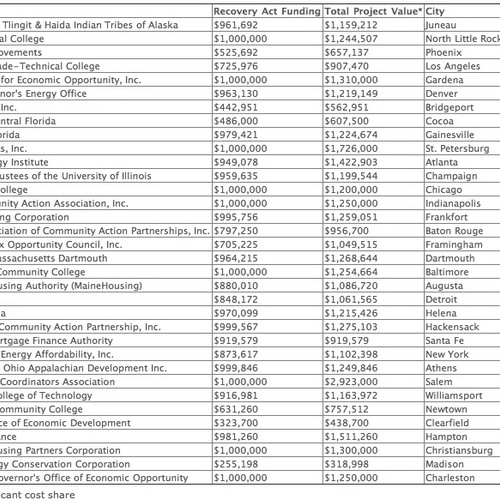Will 2010 be the year stimulus-funded green programs finally produce their intended results? If recent stories about weatherization and green-jobs programs in Georgia and Minnesota are any indication, we may be on the verge of finding out.
A lot is riding on outcomes over the next several months. And the scrutiny hasn’t let up. Over the past half year, while stimulus-program observers kept droning on about the pressures that accompany vastly expanded funding and programs, the federal, state, and community agencies managing the programs seemed to drop into increasingly cautious, almost defensive crouches as they navigated the complexities of program approvals, funding grants, wage rules, and worker training before actually beginning the process of assigning, completing, and inspecting work in the field.
There are those who say the number of green jobs that eventually will be created by successfully implemented green stimulus programs such as weatherization, product rebates, subsidy proposals, and renewable-energy tax credits might improve energy efficiency in housing much more than the overall unemployment picture. Only about $5 billion of the $787 billion stimulus package signed into law last February, after all, addresses weatherization. But given the number of housing industry workers looking for jobs, and the enormous jump in funding $5 billion represents for the decades-old Weatherization Assistance Program, many people still expect green-job creation, and other outlays for energy-conservation businesses and projects, to move the needle on the employment meter at least a little toward the positive.
In the North Star State
A recent story in the Minneapolis Star-Tribune, for example, focuses on the slow rate of green-job growth in the state, where the unemployment rate was last pegged at 7.4% but is expected to reach 8% this year.
“We, as a state, have gotten a more realistic view of the contribution that green jobs can make to the state’s economy,” state economist Tom Stinson told the paper. “They are not going to solve all the state’s economic problems. They are going to help around the edges … (but) they are unlikely to have much impact on big-picture job growth.”
The president of one company mentioned in the story, solar-collector manufacturer Solar Skies, told the paper that the Department of Energy’s slow pace in approving a rebate program for the purchase of solar power systems essentially halted sales in the sector and prompted him to cut four jobs, leaving him with a staff of 10. The story also cites financial strains in the proposed Central Corridor light-rail project in St. Paul, layoffs at a wind turbine plant, and deep job cuts at a New Flyer hybrid-bus plant in St. Cloud.
A fresh round of federal rebates for solar installations, meanwhile, is in fact slated to start in February, which should help revive the solar power industry in the state, said Lynn Hinkle, policy director of the new Minnesota Solar Energy Industry Association. Hinkle pointed out that rebates will prompt sales of about 300 solar installations on homes and businesses. The Star-Tribune article also notes that Cardinal Glass, in Northfield, expects to receive $7.7 million of new federal funds to convert its residential-glass factory into a solar glass-coating plant that lost 30 of its 120 workers to the housing recession in two years.
In Georgia
A recent story in the Atlanta Journal-Constitution focuses on Georgia’s slow rollout of the stimulus-expanded weatherization program, which by the end of November had seen contractors complete work on 430 of the 13,617 homes the state wants to weatherize by March 2012.
We keep hearing stories like this, but also acknowledge the predictably cumbersome process and occasional points of confusion that precipitate them.
“Frankly, we didn’t obviously jump on spending [the stimulus money] right away,” Phil Foil, executive director of the Georgia Environmental Facilities Authority, the state agency overseeing federal spending on weatherization, told the paper. “We wanted to take a very steady approach to this project. It is a lot of money. And we want to be good stewards of the taxpayer dollars.”
The story notes that more than 11,000 people have requested weatherization audits, although most still have to qualify for the program, which is designed for low-income homeowners. So far, the state has signed $99 million in stimulus contracts with its existing network of weatherization specialists – 22 community action agencies, nonprofits, and local governments – but also has lined up other agencies that could help out should the existing network become overwhelmed.
The administration’s take
In a report released on January 15, the White House highlighted overall progress on green-job creation, including figures that it says show the American Recovery and Reinvestment Act saved or created 63,000 jobs and is expected to create more than 700,000 by 2012. By the end of December 2009, the report adds, $263.3 billion of the original $787 billion had been outlayed or gone to American households and businesses in the form of tax reductions, while another $149.7 billion has been committed to projects and activities like the weatherization program.
And while Georgia has been slow to implement the final stages of its program (completing and inspecting work in homes), the Department of Energy’s seems reasonably satisfied with the state’s approach to building a foundation for the expanded program.
“The Department of Energy is encouraged by the overall performance of Georgia’s weatherization program,” Matt Rogers, the Energy Department’s senior adviser for Recovery Act implementation, told the Journal-Constitution. “The weatherization network in the state has been among the top 20 percent of states nationally in terms of efficiency and weatherization spending. … We look forward to working with Georgia to continue accelerating the pace of weatherization and ensure they remain a top service provider across the weatherization network.”
Weekly Newsletter
Get building science and energy efficiency advice, plus special offers, in your inbox.














0 Comments
Log in or create an account to post a comment.
Sign up Log in